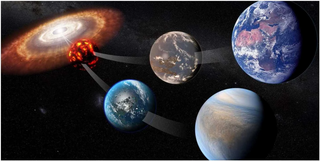Related Research Articles

Astrobiology is a scientific field within the life and environmental sciences that studies the origins, early evolution, distribution, and future of life in the universe by investigating its deterministic conditions and contingent events. As a discipline, astrobiology is founded on the premise that life may exist beyond Earth.

Space exploration is the use of astronomy and space technology to explore outer space. While the exploration of space is currently carried out mainly by astronomers with telescopes, its physical exploration is conducted both by uncrewed robotic space probes and human spaceflight. Space exploration, like its classical form astronomy, is one of the main sources for space science.

The following outline is provided as an overview and topical guide to space science:

Planetary habitability is the measure of a planet's or a natural satellite's potential to develop and maintain environments hospitable to life. Life may be generated directly on a planet or satellite endogenously or be transferred to it from another body, through a hypothetical process known as panspermia. Environments do not need to contain life to be considered habitable nor are accepted habitable zones (HZ) the only areas in which life might arise.

The habitability of natural satellites describes the study of a moon's potential to provide habitats for life, though is not an indicator that it harbors it. Natural satellites are expected to outnumber planets by a large margin and the study is therefore important to astrobiology and the search for extraterrestrial life. There are, nevertheless, significant environmental variables specific to moons.

Transiting Exoplanet Survey Satellite is a space telescope for NASA's Explorer program, designed to search for exoplanets using the transit method in an area 400 times larger than that covered by the Kepler mission. It was launched on 18 April 2018, atop a Falcon 9 launch vehicle and was placed into a highly elliptical 13.70-day orbit around the Earth. The first light image from TESS was taken on 7 August 2018, and released publicly on 17 September 2018.

An Earth analog, also called an Earth analogue, Earth twin, or second Earth, is a planet or moon with environmental conditions similar to those found on Earth. The term Earth-like planet is also used, but this term may refer to any terrestrial planet.

The Nancy Grace Roman Space Telescope is a NASA infrared space telescope in development and scheduled to launch by May 2027.

An exoplanet is a planet located outside the Solar System. The first evidence of an exoplanet was noted as early as 1917, but was not recognized as such until 2016; no planet discovery has yet come from that evidence. What turned out to be the first detection of an exoplanet was published among a list of possible candidates in 1988, though not confirmed until 2003. The first confirmed detection came in 1992, with the discovery of terrestrial-mass planets orbiting the pulsar PSR B1257+12. The first confirmation of an exoplanet orbiting a main-sequence star was made in 1995, when a giant planet was found in a four-day orbit around the nearby star 51 Pegasi. Some exoplanets have been imaged directly by telescopes, but the vast majority have been detected through indirect methods, such as the transit method and the radial-velocity method. As of 1 October 2023, there are 5,506 confirmed exoplanets in 4,065 planetary systems, with 878 systems having more than one planet. This is a list of the most notable discoveries.

Lisa Kaltenegger is an Austrian world-leading astronomer with expertise in the modeling and characterization of exoplanets and the search for life. On July 1, 2014, she was appointed Associate Professor of Astronomy at Cornell University. Previously, she held a joint position at the Max Planck Institute for Astronomy in Heidelberg where she was the Emmy Noether Research Group Leader for the "Super-Earths and Life" group, and at the Center for Astrophysics | Harvard & Smithsonian in Cambridge, MA. She was appointed Lecturer in 2008 at Harvard University and 2011 at University of Heidelberg.

Technosignature or technomarker is any measurable property or effect that provides scientific evidence of past or present technology. Technosignatures are analogous to biosignatures, which signal the presence of life, whether intelligent or not. Some authors prefer to exclude radio transmissions from the definition, but such restrictive usage is not widespread. Jill Tarter has proposed that the search for extraterrestrial intelligence (SETI) be renamed "the search for technosignatures". Various types of technosignatures, such as radiation leakage from megascale astroengineering installations such as Dyson spheres, the light from an extraterrestrial ecumenopolis, or Shkadov thrusters with the power to alter the orbits of stars around the Galactic Center, may be detectable with hypertelescopes. Some examples of technosignatures are described in Paul Davies's 2010 book The Eerie Silence, although the terms "technosignature" and "technomarker" do not appear in the book.

The Nexus for Exoplanet System Science (NExSS) initiative is a National Aeronautics and Space Administration (NASA) virtual institute designed to foster interdisciplinary collaboration in the search for life on exoplanets. Led by the Ames Research Center, the NASA Exoplanet Science Institute, and the Goddard Institute for Space Studies, NExSS will help organize the search for life on exoplanets from participating research teams and acquire new knowledge about exoplanets and extrasolar planetary systems.
Breakthrough Initiatives is a science-based program founded in 2015 and funded by Julia and Yuri Milner, also of Breakthrough Prize, to search for extraterrestrial intelligence over a span of at least 10 years. The program is divided into multiple projects. Breakthrough Listen will comprise an effort to search over 1,000,000 stars for artificial radio or laser signals. A parallel project called Breakthrough Message is an effort to create a message "representative of humanity and planet Earth". The project Breakthrough Starshot, co-founded with Mark Zuckerberg, aims to send a swarm of probes to the nearest star at about 20% the speed of light. The project Breakthrough Watch aims to identify and characterize Earth-sized, rocky planets around Alpha Centauri and other stars within 20 light years of Earth. Breakthrough plans to send a mission to Saturn's moon Enceladus, in search for life in its warm ocean, and in 2018 signed a partnership agreement with NASA for the project.

ASTERIA was a miniaturized space telescope technology demonstration and opportunistic science mission to conduct astrophysical measurements using a CubeSat. It was designed in collaboration between the Massachusetts Institute of Technology (MIT) and NASA's Jet Propulsion Laboratory. ASTERIA was the first JPL-built CubeSat to have been successfully operated in space. Originally envisioned as a project for training early career scientists and engineers, ASTERIA's technical goal was to achieve arcsecond-level line-of-sight pointing error and highly stable focal plane temperature control. These technologies are important for precision photometry, i.e., the measurement of stellar brightness over time. Precision photometry, in turn, provides a way to study stellar activity, transiting exoplanets, and other astrophysical phenomena.
The Pioneers or Astrophysics Pioneers Program is a NASA program started in 2020 intended to use small-size hardware. The missions are expected to include SmallSats, Balloon payloads, and payloads attached to the ISS, with a $20M cost cap.

Dr Aki Roberge is a research astrophysicist at NASA’s Goddard Space Flight Center, where she is currently the Associate Director for Technology and Strategy. Her research focuses on observational studies of debris disks and planet formation around nearby young stars, with an aim to be able to characterize planets around other stars, perhaps even to find signs of life on them. She is particularly known for her research on the debris disk around Beta Pictoris.
References
- 1 2 Center, NASA's Goddard Space Flight. "Pandora mission would expand NASA's capabilities in probing alien worlds". phys.org. Retrieved 2021-11-13.
- ↑ "Astrophysics Pioneers | Science Mission Directorate". science.nasa.gov. Retrieved 2022-11-17.
- ↑ "Probing Alien Worlds: NASA's Pandora Mission Builds on UArizona Research". University of Arizona News. 2021-03-24. Retrieved 2022-11-17.
- ↑ Tomaswick, Andy (2021-01-26). "NASA has Chosen 4 new Pioneer Missions: Aspera, Pandora, StarBurst, and PEUO". Universe Today. Retrieved 2022-12-20.
- ↑ "Pandora mission to study stars and exoplanets continues toward flight". www.llnl.gov. Retrieved 2022-11-17.
- ↑ Gilbert, E.; Quintana, E.; Dotson, J.; Colon, K.; Pandora Team (2021-06-01). The Pandora SmallSat Mission. American Astronomical Society meeting #238. Vol. 53. p. 309.03. Bibcode:2021AAS...23830903G.
- ↑ "The Pandora SmallSat: Multiwavelength Characterization of Exoplanets and their Host Stars - Astrobiology". astrobiology.com. 17 August 2021. Retrieved 2021-11-13.
- ↑ Talbert, Tricia (2021-01-06). "NASA Selects 4 Concepts for Small Missions to Study Universe's Secrets". NASA. Retrieved 2022-12-06.